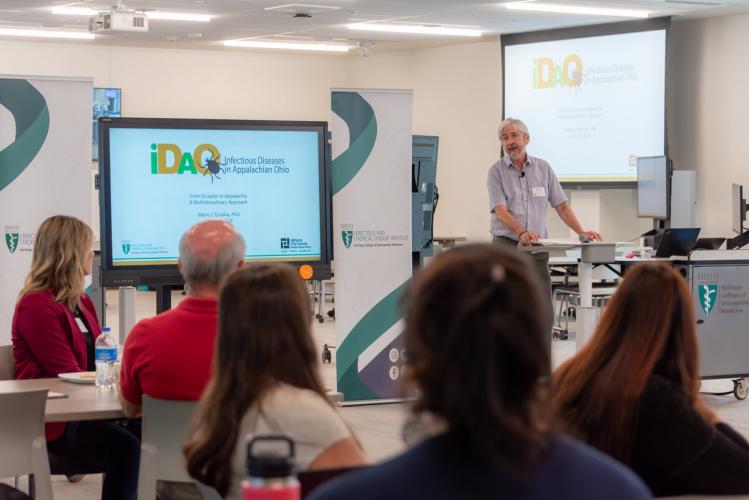
First Infectious Diseases in Appalachian Ohio Summit looks at dramatic rise in tick-borne disease

When Timothy McDermott, D.V.M., a national expert on ticks and tick-borne diseases, recently spoke to a gathering of Southeast Ohio health officials, he said he wanted them to be alarmed by what they heard. That’s because there has been a 35-fold increase in the number of Lyme disease cases in Ohio over the past 13 years. Even if they don’t know it, an estimated nine percent of Americans have had Lyme disease, which is carried by deer ticks.
McDermott called it a “global public disaster.”

McDermott, an assistant professor with The Ohio State University Extension, gave the keynote address at the inaugural Infectious Diseases in Appalachian Ohio Summit, held by the Ohio University Heritage College of Osteopathic Medicine’s Infectious and Tropical Disease Institute (ITDI) and co-sponsored by the Athens City-County Health Department.
Since its founding, ITDI has focused much of its attention in Ecuador investigating Chagas disease, which is spread to humans through insects. But now Mario Grijalva, Ph.D., ITDI director and a professor of microbiology, has decided to take what he learned about fighting infectious diseases in Ecuador and apply it to Appalachia.
“While Appalachia and Ecuador may seem worlds apart, their populations face similar challenges. Maybe the solutions are going to be different, but the way we reach those solutions can be similar,” said Grijalva. “We are beginning this initiative with a blank slate, just like what I did in Ecuador.”
One of Grijalva’s biggest a-ha moments in the fight against Chagas came when he realized that it wasn’t enough to conduct research and publish it. If he wanted to improve the health of communities that struggled with the disease, he would need to take an interdisciplinary approach to tackling Chagas. So, he tapped into the collective expertise and knowledge of local leaders, educators and health officials to accelerate change. He also invited more than 1,000 students to participate in the community-based research programs that were established.
Grijalva said the students contributed “their youth, their energy and their enthusiasm while also receiving valuable training, building connections with the communities we serve.”
As he did in Ecuador, Grijalva hopes to build a collaborative network of experts to develop research and education initiatives that address infectious diseases, such as tick-borne diseases, that negatively impact the health of those living in Appalachia.
The discussion about the problem with ticks brought more than 60 individuals including county medical directors, epidemiologists, health commissioners and others to the Summit.

Barbara Bradley with the Marietta/Belpre Health Department applauded the Summit saying it was important for Southeast Ohio to get ahead of infectious diseases because they don’t just exist in the tropics, and tick-borne diseases are a major concern in this region.
“It’s going to be a problem. It already is, and it’s going to get worse,” she said.
“We’ve seen Lyme disease blowing up since about 2018,” said Adam Masters, an epidemiologist with the Licking County Health Department. “We’ve already set some records from what we’ve seen in past years…It keeps going up every year.”
Masters said the county has assembled a team dedicated to tackling Lyme disease and is trying to raise awareness among residents as well as health care providers, who he said are not aware of all the tick-borne diseases and their symptoms.
The first summit was not a passive experience for attendees, who broke into groups to discuss what the region needs to better address infectious disease, how the university could assist local health leaders to prevent, communicate about and take action to fight infectious diseases, how data collection and sharing could be improved, current best practices and gaps in testing protocols, and whether health care providers are effectively diagnosing and reporting infectious diseases.
From the discussions, ITDI hopes to develop an action plan and start the process of creating a centralized network that can advance science, education and training that improves the ability of communities to prevent, control and treat infectious diseases.
Grijalva told attendees, “I am not here to give you sliced bread. We all know these efforts will take time. Building capacity requires years. It involves a constant effort. It involves small, incremental steps that establish a foundation for a sustainable, long-term effort something a few years from now we will all be able to take pride in.”
Grijalva said the first summit got attendees in the door, but “I want you to show up the second time, to continue engaging…I am confident that together we can achieve significant improvements.”
